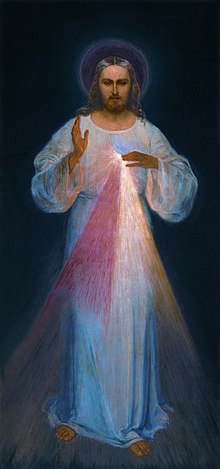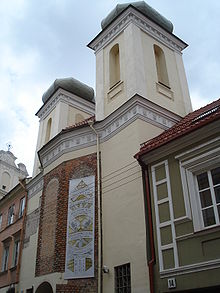Divine Mercy image


The Image of the Divine Mercy is a painting of Jesus.
The painting shows Jesus raising his right hand in a gesture of blessing and pointing with his left hand on His chest from which gush forth two rays: one red and one white (translucent). The picture by Adolf Hyła contains the message "Jesus, I trust in You!" (Polish: Jezu ufam Tobie) shown underneath to emphasize the meaning of the figure. The rays streaming out have symbolic meaning: red for the blood of Jesus (which is the life of souls) and pale for the water (which justify souls) (from Diary - 299). The whole image is symbolic of the mercy, forgiveness and love of God.
According to the Diary of Saint Faustina, Jesus will grant special protection and mercy to any city that venerates the Image and any home that displays it. The original image is currently on display in the altar of the Sanctuary of Divine Mercy in Vilnius, Lithuania.[1]
The First Painting
The first painting was painted by Eugeniusz Kazimirowski, under the supervision of Sister and Saint Faustina Kowalska and her confessor, Michał Sopoċko, in Wilno in 1934. She claimed that the command to commission painting of the Image came from Jesus Christ Himself.
Her diary entries show that actually Jesus told her to paint Him, the way she saw Him in her cell in Płock. So the sister went to her mother superior and told her about that. The mother superior, unsure whether to believe Faustina‘s story gave her a paintbrush and told her: "Then paint [him], sister!". Sister Faustina even tried to paint Jesus herself, but eventually had to resign because she did not have the necessary abilities.
So her confessor and fatherly friend, Michał Sopoċko, found a painter in Wilno, where Faustina was living then. Kazimirowski had painted religious images before, but this task was very difficult to him. Father Sopocko posed himself as Jesus for the image, wearing an alb, and both he and Faustina regularly visited the painter‘s workshop. The final painting didn‘t satisfy Father Sopocko, nor did Faustina like it. But in her diary she wrote that Jesus told her that it is not that important if the picture be beautiful. The true beauty would be the blessing, he, Jesus, would bestow to the people by the means of this painting.
The Image of the Divine Mercy visualizes an event recorded in the gospel according to St. John. Jesus enters the cenacle, where the apostles have gathered in prayer. He raises his hand in blessing and institutes what Roman Catholics call the sacrament of reconciliation. Father Sopoċko was especially disappointed that the Kazimirowski image had a dark background, giving no hint that the event takes place in the cenacle.
Other people criticized the Kazimirowski Jesus for bearing to much resemblance to Sopocko himself. The way Jesus' feet are standing on the ground, and the way Jesus gives the blessing are clearly those of Father Sopoċko.
Controversy regarding the transfer
Much controversy took place on September 28, 2005, when the first Divine Mercy painting by Eugeniusz Kazimirowski was transferred from a "Polish" church of the Holy Spirit to a "Lithuanian" one.[2][3][4] The Lithuanian side stated motivation of this move were bad conditions it was held in, and need for renovation. After renovation it was assigned to the recently renovated Sanctuary of Divine Mercy that could offer superior conditions. The Polish side claims that force was used against a protesting woman.[4]
The Second Painting
The second painting of the Divine Mercy was made by Adolf Hyła, as an ex-voto. Through painting this picture, Hyła expressed his gratitude for the survival of his family during World War II.
Hyła's image is much different from Kazimirowski's. Sopoċko had sent copies of the original image to Hyła, together with annotations and descriptions, but Hyła basically disregarded them, which angered Sopoċko.[citation needed]
Hyła figured Jesus as a "divine physician", walking on earth and healing people. His Jesus of the Divine Mercy doesn't stand, he's approaching the viewer. His right hand is lifted up very high and he is looking into the eyes of the viewer. The original Hyła painting pictured Jesus in front of a country landscape which was later obliterated because it was "non-liturgical". The Hyła rendition is also called the "Kraków Divine Mercy Image" because it is kept in Sanctuary in Kraków-Łagiewniki.
The Third Painting
A third image that has achieved popularity is the image created in the 1970s by the American artist Robert Skemp [5]. This rendition depicts Jesus as standing in front of an arched doorway, with a more pronounced halo around his head. This image, together with the Hyła rendition, is the oft-seen version in the Philippines, where the devotion to the Divine Mercy is a popular one.
